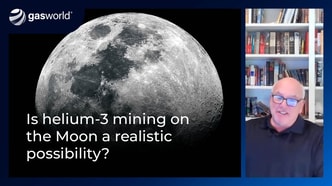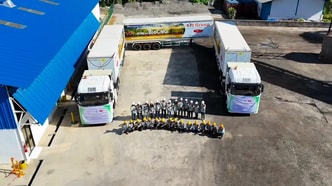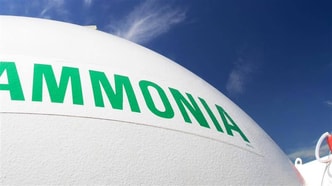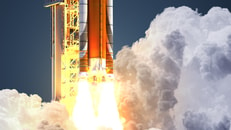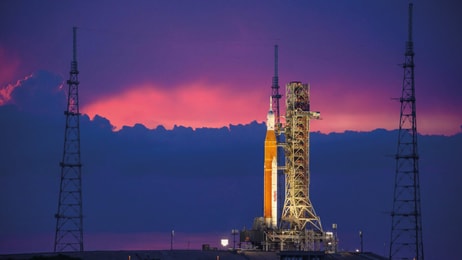The space race and cryogenic systems
Fifty-three years ago, three men, with a team of nearly 400,000 people behind them, did what was previously thought impossible: they went to the Moon.
Collins, Armstrong, and Aldrin’s names went down in history as the crew of Apollo 11, markers of the feats of the human race. Six moon-landing missions were to follow Apollo 11, the last ending near the close of 1972.
This fall, NASA is going back. To do so, they have spent the past decade building the Space Launch System (SLS), a 70 metric tonnes, 321 foot tall rocket with 8.4 million pounds of thrust at take-off, carrying nearly 154,000 pounds of payload.
The first Orion spacecraft launch is part of NASA’s new Artemis programme, named for Apollo’s twin sister in Greek mythology. Artemis I, as the uncrewed mission is dubbed, will be the first in a series of missions intending to take humans back to the moon, with Artemis II planned to be an all-female crew in cislunar operation following a successful Artemis I. NASA hopes to recapture public imagination through these missions, advance scientific innovation, and pave the way for deep space exploration.
Luckily, NASA doesn’t have to wait for a Moon-landing to bring scientific innovations to the forefront; it will accomplish this through the commission and construction of SLS and the subsequent development of planned Artemis missions. Building the launch vehicle was no easy feat (as evidenced by the decade-long timestamp). The effort took patience, innovation, and partnerships. Technetics was one such contributor.
Working on the core and upper stages, Technetics advanced the integrity of the launch system through custom-engineered sealing. The SLS engines required sealing solutions and fluid management components which could withstand all variable conditions of a rocket launch. No easy feat. Through research and design, the Technetics team came up with engineered solutions, including custom metal seals, carbon face seals, edge-welded metal bellows and accumulators – to name a few.
Now more than ever, private companies are instrumental in developing and constructing publicly-funded missions like the Artemis programme. And if the goals of the Artemis programme are to ring true, more private innovation is needed. The Artemis I long-class test will eventually lead to a crew returning to the Moon, and the hope is that Artemis will pave the way for a deep space exploration programme to an untouched planet: Mars. However, a critical piece to getting there is the missions in-between.
 One private space company founded in 2019, Eta Space, has been tasked by NASA to develop critical elements of the Artemis programme. This includes orbital availability of propulsive cryogenic fluids and designing refuelling satellite systems. The names for these two missions are LOXSAT and Cryo-Dock.
One private space company founded in 2019, Eta Space, has been tasked by NASA to develop critical elements of the Artemis programme. This includes orbital availability of propulsive cryogenic fluids and designing refuelling satellite systems. The names for these two missions are LOXSAT and Cryo-Dock.
LOXSAT’s planned launch is in spring 2024, and development is in motion. The mission plans to test cryogenic fluid management technologies, and the Technetics Group is already working in partnership with Eta Space to build the first set of burst discs for the LOXSAT mission. The burst discs may replace NASA’s relief valves, as one burst disc operates as the equivalent of two valves.
With a track record of reliability in outer space, the burst disc is critical in managing cryo fluids and preventing loss of product pressure – allowing pressure-dependent components to function normally. Eta Space and Technetics companies are working together to make cryogenic systems usable in space.
Dr. William Notardonato, CEO of Eta Space, provided insight on the private partnership, “We are working with Technetics to develop specific relief valve/burst disc assemblies to our unique requirements. Fortunately, they have previous experience developing relief assemblies for other spacecraft, and we can capitalise on this unique experience and close working relationship until space-based standards are developed.”
Under Artemis, LOXSAT precedes the Cryo-Dock mission as an operational technology test. But Cryo-Dock will be the first fully commercial cryogenic propellant depot in space. Eta Space’s design will service spacecraft stages and orbital vehicles with cryogenic propellants through an automatic umbilical. Having worked at NASA for 30 years, Dr. Notardonato recognised the value of developing a commercial cryogenic space asset. He said, “Cryo-Dock will enable re-usable spacecraft to help reduce the cost of operations in space. Imagine how much air travel would cost if each aircraft were built for one use with no ability to refuel. The capability to refuel in orbit will make space exploration much more sustainable. Other companies are developing small-scale refuelling of satellites, but Eta Space is the only one currently developing an agnostic, standardised cryogenic refuelling station for multiple customers.”
Both missions represent the difficulty of creating, designing, and implementing a cryogenic system usable in space. Launch costs for the lunar surface currently cost over 20 times as much as Low-Earth Operations (LEO). This means the planned cryogenic systems on the moon have to be extremely reliable since there is limited maintenance capability and currently no way to replace a disc once it is there.
The reliability of Technetics burst discs is invaluable for the technologies Eta Space is developing. Reflecting on the partnership, Kingston Vickers, Aerospace Manager at Technetics, said, “At Technetics, we develop engineered solutions for demanding environments; few of those environments are as unforgiving as space. Having a world-class company like Eta Space place their trust in our solution means and matters a lot to us.”
Safe operational cryogenic technology is the critical differentiator between a successful and unsuccessful mission and the long-term viability of the Artemis programme.
Working on this programme, companies have to operate under the confluence of coordination and communication, and the future success of (at least) two Artemis missions would be impossible if not for the work of Eta Space. Founded by former NASA cryogenic engineers, Eta Space develops and deploys the most efficient cryogenic propellant management systems on the commercial market. Staggering launch costs make any mistakes in the system build costly and, according to Dr. Notardonato, “…can impact our company’s ability to lead the development of cryogenic propellant depots and damage our competitive advantages. Mission success is absolutely critical, so careful selection of vendors with proven reliability is necessary.”
National and international partners alike strive toward producing viable lunar operations. And while NASA’s Artemis programme will take humans back to the moon, it will open up more partnership opportunities between private and public space organisations. On the lunar service, Eta Space and Helios, a space technology company, have partnered with the Israel Space Agency to extract and store liquid oxygen on the lunar surface. The moon, with no atmosphere with which to store oxygen, has nearly 45% oxygen weight in its’ rocks and soil. Partially funded by the Israel Space Agency and Space Florida, the plan will see Eta Space and Helios operate conjointly to build a cryogenic and chemically engineered oxygen extraction and production method. The development of this system will ultimately be used for lunar surface development. “In order to enable the establishment of a permanent lunar base, Helios’ technology is not enough – a whole set of technologies are required to realise the lunar economic value chain,” said Jonathan Geifman, Helios CEO and co-founder.
“This new collaboration with Eta Space will for the first time connect two purely commercial links in the chain – the production and the storage of oxygen – thus making multiple and long-term missions to the Moon closer to being economically viable.”
Dr. Notardonato noted the significance of the current partnership, “Since oxygen is the common element across all planned Lunar systems, we started working with Helios to produce just oxygen from the Lunar regolith. Helios is developing a system to make gaseous oxygen from the lunar regolith with high efficiency. They have the vision to be a premier supplier of lunar oxygen and a roadmap to scale this technology to hundreds of metric tons per month.”
Ultimately, this international partnership will be critical in developing a sustainable lunar industry.
For Eta Space, the engineering process also represents an avenue for multi-use applications. Their original Lunar Propellant Production Plant (LP3) contract was with NASA, which included liquid hydrogen and liquid oxygen produced from the electrolysis of lunar ice. The LP3 system may apply to Earth-based operations, making LH2 (liquid hydrogen) from water and solar energy for ‘green hydrogen’. Dr. Notardonato reflected on the multiple applications of the technology, “In keeping with the energy efficiency theme on hydrogen energy, in our past careers at NASA, Eta Space engineers have developed zero-loss storage and transfer systems for large-scale liquid hydrogen systems. This includes a test in which we stored 125 cubic metres of LH2 in a zero-loss state for 18 months with absolutely zero boil-off. The same test created densified hydrogen in the slush state. These tests were so successful that NASA KSC incorporated this Integrated Refrigeration and Storage (IRAS) capability into the 5,300 cubic metre hydrogen sphere that has been built at Launch Complex 39B in support of the Space Launch System (SLS) Programme.”
The value of partnerships in the space industry, whether private or public, can be seen through the various innovations and exploration programmes currently underway. Whether designing space operational burst discs or creating cryogenic systems with multi-use applications, outer space is an arena ripe for opportunity and collaboration. Space development isn’t happening without the innovations and partnerships of the commercial sector to back it. With current international and domestic partners developing systems for the viability of the Artemis programme, going to the Moon and beyond will require a long-term effort from a cosmic-sized team.





